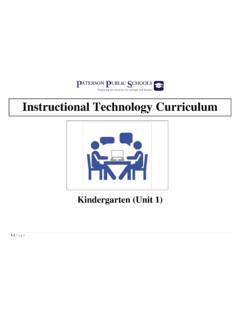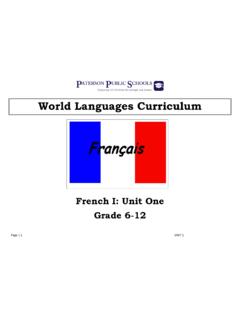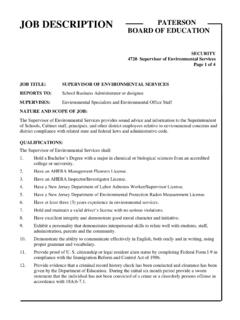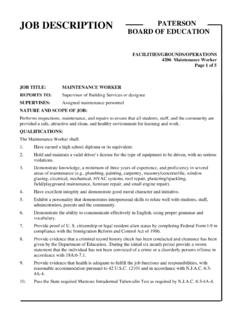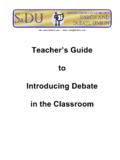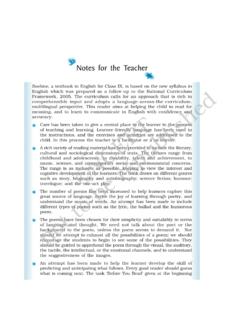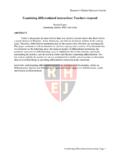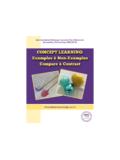Transcription of Visual Arts Curriculum - Paterson, New Jersey -curriculum ...
1 Visual Arts Curriculum Grade 6: Unit Four Clay Sculpture 1|Page Course Description From a psychological developmental perspective, sixth graders are beginning to think about who they are, where they come from, and where they are going. In the art studio classroom, sixth graders will explore these ideas and use art materials to express their feelings about these very real philosophical thoughts. They will draw, paint, sculpt clay, and make puppets. 2|Page Pacing Chart Unit 1 Drawing 10 weeks Unit 2 Puppetry 16 weeks Unit 3 Painting 6 weeks Unit 4 Clay Sculpture 4 weeks 3|Page Educational Technology Standards , , , , Creativity and Innovation Students demonstrate creative thinking, construct knowledge, and develop innovative products and processes using technology. Apply existing knowledge to generate new ideas, products, or processes Create original works as a means of personal or group expression Use models and simulations to explore complex systems and issues Identify trends and forecast possibilities Critical Thinking, Problem Solving, Decision Making Students use critical thinking skills to plan and conduct research, manage projects, solve problems, and make informed decisions using appropriate digital tools and resources.
2 Identify and define authentic problems and significant questions for investigation Plan and manage activities to develop a solution or complete a project Collect and analyze data to identify solutions and/or make informed decisions Use multiple processes and diverse perspectives to explore alternative solutions (from ). 4|Page Career Ready Practices Career Ready Practices describe the career-ready skills that all educators in all content areas should seek to develop in their students. They are practices that have been linked to increase college, career, and life success. Career Ready Practices should be taught and reinforced in all career exploration and preparation programs with increasingly higher levels of complexity and expectation as a student advances through a program of study. CRP1. Act as a responsible and contributing citizen and employee Career-ready individuals understand the obligations and responsibilities of being a member of a community, and they demonstrate this understanding every day through their interactions with others.
3 They are conscientious of the impacts of their decisions on others and the environment around them. They think about the near-term and long-term consequences of their actions and seek to act in ways that contribute to the betterment of their teams, families, community and workplace. They are reliable and consistent in going beyond the minimum expectation and in participating in activities that serve the greater good. CRP2. Apply appropriate academic and technical skills. Career-ready individuals readily access and use the knowledge and skills acquired through experience and education to be more productive. They make connections between abstract concepts with real-world applications, and they make correct insights about when it is appropriate to apply the use of an academic skill in a workplace situation CRP3. Attend to personal health and financial well-being. Career-ready individuals understand the relationship between personal health, workplace performance and personal well-being; they act on that understanding to regularly practice healthy diet, exercise and mental health activities.
4 Career-ready individuals also take regular action to contribute to their personal financial wellbeing, understanding that personal financial security provides the peace of mind required to contribute more fully to their own career success. Career Ready Practices CRP4. Communicate clearly and effectively and with reason. Career-ready individuals communicate thoughts, ideas, and action plans with clarity, whether using written, verbal, and/or Visual methods. They communicate in the workplace with clarity and purpose to make maximum use of their own and others' time. They are excellent writers; they master conventions, word choice, and organization, and use effective tone and presentation skills to articulate ideas. They are skilled at interacting with others; they are active listeners and speak clearly and with purpose. Career-ready individuals think about the audience for their communication and prepare accordingly to ensure the desired outcome.
5 CRP5. Consider the environmental, social and economic impacts of decisions. Career-ready individuals understand the interrelated nature of their actions and regularly make decisions that positively impact and/or mitigate negative impact on other people, organization, and the environment. They are aware of and utilize new technologies, understandings, procedures, materials, and regulations affecting the nature of their work as it relates to the impact on the social condition, the environment and the profitability of the organization. CRP6. Demonstrate creativity and innovation. Career-ready individuals regularly think of ideas that solve problems in new and different ways, and they contribute those ideas in a useful and productive manner to improve their organization. They can consider unconventional ideas and suggestions as solutions to issues, tasks or problems, and they discern which ideas and suggestions will add greatest value.
6 They seek new methods, practices, and ideas from a variety of sources and seek to apply those ideas to their own workplace. They take action on their ideas and understand how to bring innovation to an organization. CRP7. Employ valid and reliable research strategies. Career-ready individuals are discerning in accepting and using new information to make decisions, change practices or inform strategies. They use reliable research process to search for new information. They evaluate the validity of sources when considering the use and adoption of external information or practices in their workplace situation. Career Ready Practices CRP8. Utilize critical thinking to make sense of problems and persevere in solving them. Career-ready individuals readily recognize problems in the workplace, understand the nature of the problem, and devise effective plans to solve the problem. They are aware of problems when they occur and take action quickly to address the problem; they thoughtfully investigate the root cause of the problem prior to introducing solutions.
7 They carefully consider the options to solve the problem. Once a solution is agreed upon, they follow through to ensure the problem is solved, whether through their own actions or the actions of others. CRP9. Model integrity, ethical leadership and effective management. Career-ready individuals consistently act in ways that align personal and community-held ideals and principles while employing strategies to positively influence others in the workplace. They have a clear understanding of integrity and act on this understanding in every decision. They use a variety of means to positively impact the directions and actions of a team or organization, and they apply insights into human behavior to change others' action, attitudes and/or beliefs. They recognize the near-term and long-term effects that management's actions and attitudes can have on productivity, morals and organizational culture. CRP10. Plan education and career paths aligned to personal goals.
8 Career-ready individuals take personal ownership of their own education and career goals, and they regularly act on a plan to attain these goals. They understand their own career interests, preferences, goals, and requirements. They have perspective regarding the pathways available to them and the time, effort, experience and other requirements to pursue each, including a path of entrepreneurship. They recognize the value of each step in the education and experiential process, and they recognize that nearly all career paths require ongoing education and experience. They seek counselors, mentors, and other experts to assist in the planning and execution of career and personal goals. CRP11. Use technology to enhance productivity. Career-ready individuals find and maximize the productive value of existing and new technology to accomplish workplace tasks and solve workplace problems. They are flexible and adaptive in acquiring new technology.
9 They are proficient with ubiquitous technology applications. They understand the inherent risks-personal and organizational-of technology applications, and they take actions to prevent or mitigate these risks. Career Ready Practices CRP12. Work productively in teams while using cultural global competence. Career-ready individuals positively contribute to every team, whether formal or informal. They apply an awareness of cultural difference to avoid barriers to productive and positive interaction. They find ways to increase the engagement and contribution of all team members. They plan and facilitate effective team meetings. Differentiated Instruction Accommodate Based on Students Individual Needs: Strategies Time/General Processing Comprehension Recall Extra time for assigned tasks Extra Response time Precise step-by-step directions Teacher-made checklist Adjust length of assignment Have students verbalize steps Short manageable tasks Use Visual graphic organizers Timeline with due dates for Repeat.
10 Clarify or reword Brief and concrete directions Reference resources to reports and projects directions promote independence Provide immediate feedback Communication system between home and school Mini-breaks between tasks Visual and verbal reminders Small group instruction Provide lecture notes/outline Provide a warning for Graphic organizers transitions Emphasize multi-sensory learning Reading partners Assistive Technology Tests/Quizzes/Grading Behavior/Attention Organization Computer/whiteboard Extended time Consistent daily structured Individual daily planner routine Tape recorder Study guides Display a written agenda Simple and clear classroom Spell-checker Shortened tests rules Note-taking assistance Audio-taped books Read directions aloud Frequent feedback Color code materials 6|Page Enrichment Accommodate Based on Students individual Needs: Strategies Adaption of Material and Requirements Evaluate Vocabulary Elevated Text Complexity Additional Projects Independent Student Options Projects completed individual or with Partners Self Selection of Research Tiered/Multilevel Activities Learning Centers Individual Response Board Independent Book Studies Open-ended activities Community/Subject expert mentorships 7|Page Assessments Suggested Formative/Summative Classroom Assessments Timelines, Maps, Charts, Graphic Organizers Unit Assessments, Chapter Assessments, Quizzes (art history content, elements and principles content).
